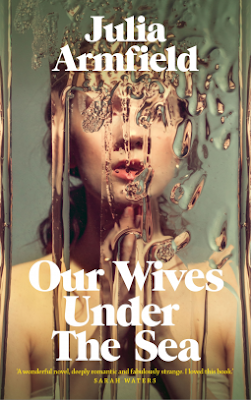This month the starting point is Our Wives Under the Sea by Julia Armfield. I don't read much contemporary fiction these days so it is unlikely that I will ever read this novel. However, part of the book's description:
Miri thinks she has got her wife back, when Leah finally returns after a deep sea mission that ended in catastrophe. It soon becomes clear, though, that Leah may have come back wrong. Whatever happened in that vessel, whatever it was they were supposed to be studying before they were stranded on the ocean floor, Leah has carried part of it with her, onto dry land and into their home ...
grabbed my attention and I immediately thought of The Kraken Wakes by John Wyndham. This is a science fiction novel that I read in my early teens. It, too, suggests that there is something horrendous in the
... deepest trenches of the oceans. Something is about to show itself, something terrible and alien, a force capable of causing global catastrophe ...
Staying with oceans and science fiction, I couldn't ignore the author dubbed as the Father of Science Fiction, Jules Verne, and his 1872 novel 20,000 Leagues Under the Sea, in which three men hunt a sea monster only to find it is a giant submarine, the Nautilus, captained by Nemo. The three men are taken onboard and share in Nemo's undersea adventures. This is another book read in my early teens and one I would like to re-read as an adult.
In a 1962 Bantam Classics edition of this book, Ray Bradbury, the author of Fahrenheit 451, wrote an introduction comparing Captain Nemo to Captain Ahab, the captain of the Pequod in Moby-Dick. Another link to Herman Melville's classic is that one of the three men who join Captain Nemo is a whaler and harpooner.
An impassioned, charming, and hilarious debut novel about a young woman's coming-of-age, during one of the harshest whaling seasons in the history of New South Wales ...
Leaving behind whaling stations by the sea, I'm travelling inland to the banks of the Darling River. My next book is another I'm eager to read and involves a different type of station - a sheep station. The latest release from Nicole Alexander entitled The Last Station is set in 1909 and tells the story of the Delahuntly Station and the riverboat trade, both of which are in decline.
From here, I'm heading south to Echuca on the Murray River, in the state of Victoria, where riverboats link to All the Rivers Run by Nancy Cato. This is an epic novel that begins in 1890 and covers 80 years. It is considered an Australian classic and is on my list to re-read.
Next month (May 7, 2022), we're starting with Peter Carey’s True History of the Kelly Gang.








I guess I'm one of the few doing this that didn't see the water connection. Lovely chain!
ReplyDeleteThe water connection was the first thing that sprang to mind, so I ran with it. Thanks, Davida!
DeleteSmart chain! Like Davida, I somehow managed to miss the watery route and went straight to the desert in mine.
ReplyDeleteThanks, Susan. I couldn't come up with anything but the water connection to start my chain.
DeleteI love John Wyndham's books but haven't read The Kracken Wakes yet. I read All the Rivers Run years ago - it's one that I would like to re-read at some point too. Great chain!
ReplyDeleteI preferred The Day of the Triffids and The Midwich Cuckoos to The Kraken Wakes. I have so many books that I would like to re-read, so I'm hoping to get to All the Rivers Run soon. Thanks, Helen!
DeleteNice work!
ReplyDeleteLisa @ https://hopewellslibraryoflife.wordpress.com/2022/04/02/six-degrees-of-separation-our-wives-under-the-sea-by-julia-armfield/
Thanks, Lisa!
DeleteI think I read that Nancy Cato when it first came out but would like to reread if I can find it. I still love those big epic stories like Thornbirds and Sara Dane. The Last Station also looks intriguing.
ReplyDeleteI'm also up for rereading Sara Dane and the Thornbirds! These two and All the Rivers Run are still available from my library.
DeleteGosh, All the Rivers Run bring back a lot of memories!!
ReplyDeleteFun chain!
Thanks, Marg!
Delete